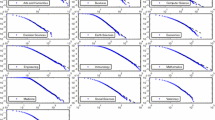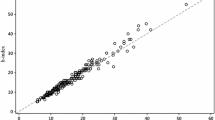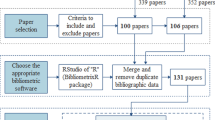Abstract
Is is shown, using rigorous statistical tests, that the number of journals (J) carryingp papers in a given subject can be expressed as a simple power law functionJ(p)=K p −γ , K and γ being constants. The standard maximum likelihood method of estimating γ has been suitably modified to take acoount of the fact thatp is a discrete integer variable. The parameter γ entirely characterises the scatter of articles in journals in a given bibliography. According to a dynamic model proposed earlier by the author, γ is a measure of the relative growth rates of papers and journals pertaining to the subject.
Similar content being viewed by others
References
S. NARANAN, Bradford's law of science bibiography: An interpretation,Nature, 227 (Aug. 8 1970) 631.
S. NARANAN, Power law relations in science bibliography: A selfconsistent interpretation,Journal of Documentation, 27 (4) (1971) 83.
S. C. BRADFORD,Documentation, Crosby Lockwood, London, 1948.
B. C. VICKERY, Bradford's law of scattering,Journal of Documentation, 4 (1948) 198.
E. A. WILKINSON, The ambiguity of Bradford's law,Journal of Documentation, 28 (2) (1972) 122.
B. C. BROOKES, Bradford's law and the bibliography of science,Nature, 224 (Dec. 6, 1969) 953.
W. GOFFMAN, K. S. WARREN, Dispersion of papers among journals based on a mathematical analysis of two diverse medical literatures,Nature, 221 (March. 29, 1969) 1205.
W. GOFFMAN, T. G. MORRIS, Bradford's law and library acquisition,Nature, 226 (June. 6, 1970) 922.
R. KALLARD (Ed.)Holography, State of the Act Review, Optosonic Press New York, 1969.
G. K. ZIPF,The Psycho-Biology of Language, Houghton Mifflin Co., New York, 1935; M. I. T. Press, 1968 (paperback).
A. J. LOTKA, The frequency distribution of scientific productivity,Journal of the Washington Academy of Sciences 16 (1926) 317.
M. G. KENDALL, The bibliography of operational research,Operational Research Quartecly, II (1, 2) (1960) 31.
A. AVRAMESCU, Coherent informational energy and entropy,Journal of Documentation, 36 (Dec. 1980) 293.
N. KARMESHU, C. LIND, V. CANO, Rationales for Bradford's law,Scientometrics, 6 (1984) 233.
E. JAHNKE, F. EMDE,Tables of Functions with Formulae and Curves, 4th ed., Dover Publications, New York, 1945.
R. A. FISHER,Statistical Methods for Research Workers, 12th ed. Oliver and Boyd, London, 1954, pp. 78–113.
D. F. CRAWFORD, D. L. JAUNCEY, H. S. MURDOCH, Maximum-likelihood estimation of the slope from number-flux-density-counts of radio sources,Astrophysical Journal, 162 (Nov. 1970) 405.
M. G. KENDALL, A. STUART,The Advanced Theory of Statistics, Vol. 2, Charles Griffin & Co., London, 1961.
Author information
Authors and Affiliations
Rights and permissions
About this article
Cite this article
Naranan, S. “Power law” version of Bradford's law: Statistical tests and methods of estimation. Scientometrics 17, 211–226 (1989). https://doi.org/10.1007/BF02026411
Received:
Issue Date:
DOI: https://doi.org/10.1007/BF02026411




